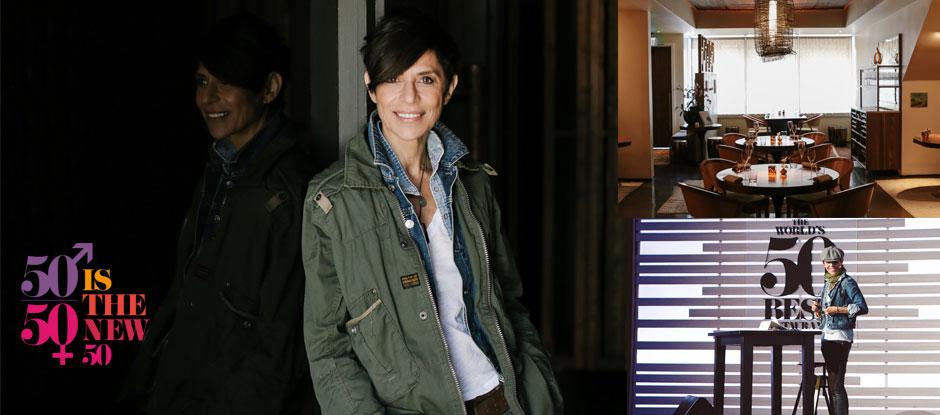Dominique Crenn of Atelier Crenn, which sits at No.35 in The World’s 50 Best Restaurants list, shares a blueprint to help ensure that women – and all individuals – can feel welcome and valued in workplaces across the globe.
Chef Crenn’s article marks the launch of 50 Best’s content series ‘50/50 is the new 50: promoting equality, inclusivity and balance’, which will feature individuals and initiatives in the restaurant and bar industries that are working to create a more humane, fair and positive environment for every member of society.
I feel both encouraged and excited to be asked about the need for improved gender equality in the restaurant industry. For me, this topic was a taboo for a long time, and many of the inequalities were not only rampant, but they were also ours – as women – to bear.
The restaurant industry does not exist in a vacuum. Society as a whole must work to address how gender inequality fails women every day, across all fields. Within the restaurant sphere, women are often treated in ways that mirror how they are treated elsewhere. No one industry should carry this responsibility alone and we should acknowledge that no one industry alone can fix it.
Today, I feel that women in the culinary arts – although not treated equally at all times – can at least know that efforts to make things better are in progress. Below, I will share some steps that can provide a base for progress in the global restaurant industry.
These changes take time and shifting a culture requires patience and attention. However, we owe it to all those who have been neglected in our industry and to all those female chefs waiting for their turn to participate in a safe and supportive environment. Here is how I envisage a seven-fold path to equality.
Step 1: Acknowledgement of the past
The first stage of change requires admitting what has not worked. As an industry, the world of restaurants has passed down and promoted a culture that included physical and emotional abuse and hardship, which have not only been unhealthy for all involved, but have also been particularly successful in excluding many women from feeling safe and included in the kitchen. This step is perhaps the hardest, as it requires all of us in the industry to take a hard look at the underbelly of our culture and be brave enough to depart from some aspects of what we have at times assumed defines us.
Step 2: Commitment to a new future
Women need to know that the industry as whole wants them to be in the kitchen. In turn, the industry needs to decide on an sector-wide level that it is committed to having women join professional kitchens, influence the world of food and make decisions that affect how we operate. This can happen through women sitting on councils, being judges on TV shows, being acknowledged for their contributions and even having culinary schools committed to recruiting and supporting female students at the very inception of their dream to pursue careers in the field.
Lara Gilmore, Gaggan Anand and Dominique Crenn at #50BestTalks in San Francisco in 2018
Step 3: Engagement in recruitment process
Each restaurant must consider how they reach out to and recruit female employees, from stagiaires to high-level recruits. Ask yourself: are women applying and if not, why? Each restaurant may need to look at how it attracts female talent or what it is doing to repel potential applicants.
Step 4: Opening communication
Once the female talent is part of the team, what needs to be considered is the space they are given on the team. This is often challenging, as paying attention to the particular experience of the female hire requires the restaurant to examine honestly how its culture surrounding gender is influencing female team members. The most direct way of learning about the female team member’s experience is to provide them with the avenues to communicate this directly to management without fear of reprisal.
Step 5: Gender awareness
Consideration should be given to the issues that are particular to female team members, as these can often be different from their male counterparts. Flexibility with regards to hours and physical demands are among the obvious areas that can affect female team members more than men. Are shifts and tasks of equal value? Are opportunities to join up, learn, strive and succeed given to all team members, regardless of gender?
Step 6: Bias eradication
Owners and managers should be willing to provide opportunities for team members to explore where they may hold unexamined gender bias through executive coaching. Often, the best-meaning managers learn they harbour unknown biases that, until identified, can guide them in their hiring decisions as well as influence how they approach gender-based issues in the workplace. This step requires financial commitment and time, but until narratives informed by gender bias are not eradicated, behaviour cannot change.
Step 7: Proactive feedback
Lastly, when a female team member leaves a restaurant, they should be given an outgoing questionnaire that specifically asks for feedback on their experience in terms of gender equality. This feedback should be considered with care and changes should made to respond to what was not in place for that particular team member.
Now watch Crenn's talk about diversity in the restaurant industry at #50BestTalks:
Stay tuned for the next articles in the ‘50-50 is the new 50’ campaign, coming soon. Follow The World’s 50 Best Restaurants on Instagram, Facebook, YouTube and Twitter for more news, videos and features from around the world.

